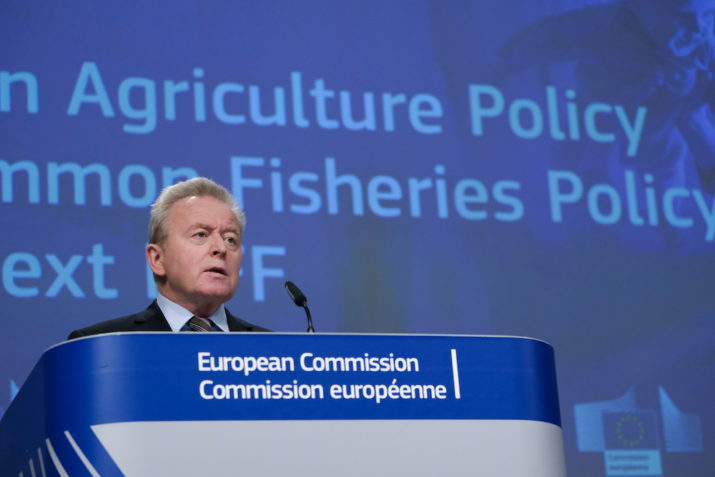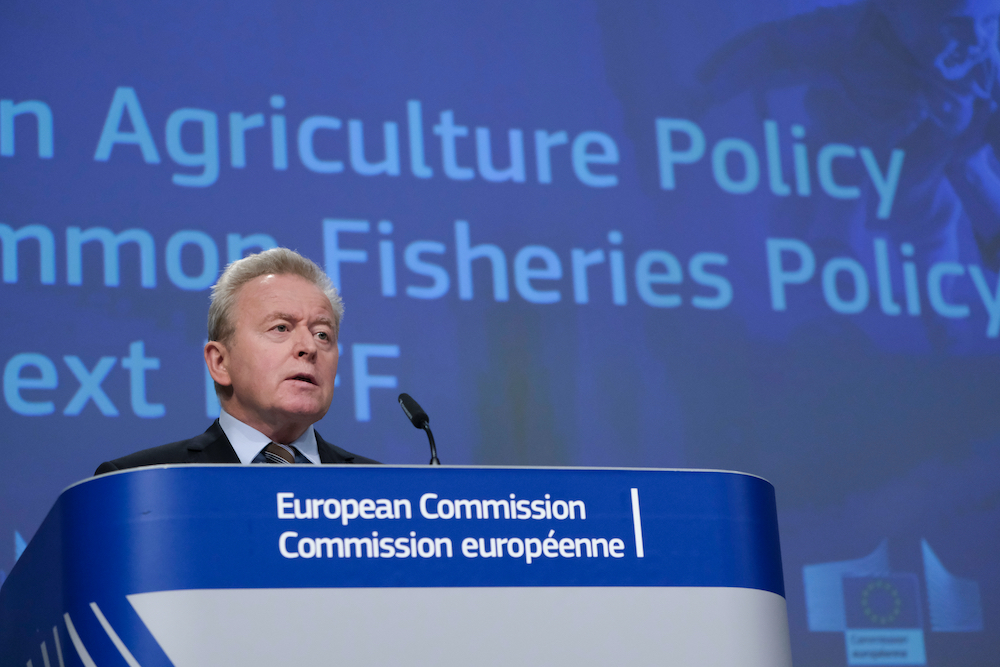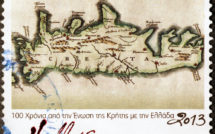

This is part of our special feature on Rurality in Europe, and a roundtable, Changing Agriculture in Rural Europe.
The Common Agricultural Policy (CAP) is the European Union’s (EU) longest lasting policy. It is the policy that has arguably most greatly influenced European farmers’ decisions. Highly controversial because of its cost and impact on the environment, today the CAP is facing a new set of challenges because of budgetary constraints and the relationship between agriculture and climate change. When the CAP originated, in the 1950s, agriculture was a much more important component of the European economy than it is today. At the time, the new policy was particularly relevant to France in economic, political, and cultural terms. Although France wanted support for its farmers as a trade-off for accepting tariff-free manufactured goods from Germany, a considerable number of part-time farmers in Germany also benefited. An important consideration was the growing income gap between urban and rural populations, and whether it might lead disadvantaged farmers to support extreme political movements on the left or right. At a time when Europe was a net food importer, there was also a concern about any interruption to sea lanes if the Cold War degenerated into armed conflict.
Objectives of the CAP
The five objectives of the CAP as set out in the Treaty of Rome, which have survived a series of treaty revisions, were in some respects contradictory. The first was to increase agricultural productivity through the promotion of technical progress and the optimal utilization of factors of production, notably labor. But technical progress was already well under way by the late 1950s and would have continued without a CAP. In fact, considerable gains had already been made through the mechanization of traction and the use of fertilizers, and these advances were supplemented by agrochemicals that controlled pests and advances in seeds, breeding, and veterinary medicine. However, the considerable sums of money that the CAP made available to farmers, especially large-scale ones, accelerated the substitution of capital for labor. Consequently, farm laborers declined in numbers and, over time, specific farming tasks became increasingly undertaken by agricultural contractors.
The second objective was stated “to ensure a fair standard of living for the agricultural community, in particular by increasing the individual earnings of persons engaged in agriculture.” However, subsidies to farm businesses showed to be an inefficient and poorly targeted way of delivering what was, in effect, a farm welfare policy. Moreover, the gap between agricultural and industrial incomes was not eliminated, and the main financial benefits were obtained by the better off large-scale farmers, as well as food processors, providers of food storage, and traders.
A third objective was to stabilize markets. For all the advances in agronomy, the weather still has a substantial impact on farm production, particularly of crops. Too cold or too hot, too wet or too dry, the weather is a major influence on levels and quality of output and the need for a certain input (for example, more energy may be needed to dry grain). This is particularly the case if the weather is unfavorable at the time of planting and early growth, or at harvesting when storm damage can have a particularly serious impact. It might seem that farmers could insure against such risks, but in practice, the premiums would be too high relative to the risk involved. Thus, the CAP introduced greater stability to markets through intervention buying of surplus products and export subsidies, so that the EU became a net food exporter. However, this was achieved at a considerable cost in budgetary terms and market distortion.
A fourth objective was one of food security, seen in terms of the availability of supplies. It has to be remembered that, in the immediate post-war period, Europe suffered severe food shortages with some countries experiencing food rations not far above the survival level. Today, food security is interpreted in broad terms in relation to the nutritional value and affordability of food. Some farming organizations insist, however, on equating food security with self-sufficiency, when in fact they are different concepts.
A final objective was “to ensure that supplies reach consumers at reasonable prices.” The protectionist policies of the CAP limited consumers’ access to cheaper supplies from outside the EU and hence pushed prices up. However, this was offset by the fact that the real cost of food, and its share of a typical family budget, fell over the lifetime of the CAP.
How the CAP worked
“During its first thirty years (1962-1992), the CAP was mostly a market intervention policy” (Collantes 2020). One of its most important instruments was intervention buying, which meant that the EU undertook to purchase surplus produce from farmers at a price that gave a floor to the market, provided certain quality standards were met. This gave farmers an incentive to maximize production, as they knew that if they could not sell on the market, the EU would always buy their production at a price that would exceed the marginal cost of production. As a consequence, supply often came to exceed demand for many commodities, leading to the infamous butter mountains and wine lakes, which had to be disposed of. One way of doing it was to sell “ageing” butter to the Soviet Union, a lucrative trade for those involved since, presumably, “ageing” butter was better for Soviet consumers than no butter at all.
Surplus produce was also dumped on world markets. For example, skimmed milk powder was dumped as another way of absorbing surplus milk production. This had a distorting effect on production in the Global South, driving local dairy producers out of business. The EU also erected a high tariff wall, with some tariffs as high as 200 percent, to ensure that domestic production was not undercut by imported produce. “Originally, the main instrument was intervention buying, but export subsidies came to be more important” (Collantes 2020, 30). However, even these measures were insufficient to deal with surplus production and milk output continued to increase as farmers enlarged their herds and dairy cows became more productive. By the 1980s, the cost of subsidizing the dairy sector had put the whole EU budget under strain. The EU therefore introduced quantitative restrictions on output at the farm level in the form of quotas on milk production and even permitted farmers to trade quota with each other.
A reformed CAP
A major challenge to these arrangements came when agriculture was brought within the scope of the General Agreement on Tariffs and Trade (GATT) in the Uruguay Round negotiations (1986-1993). Agricultural exporting countries led by Australia in the Cairns Group[1] were determined to drive down the EU’s high level of subsidy and protection. With support from the United States, their efforts were successful and the EU Producer Subsidy Equivalent (PSE)―an Organisation for Economic Cooperation and Development (OECD) measure of the percentage of gross farm income provided by subsidies― started declining significantly in the late 1980s (although in line with the OECD average) (Figure 1.).
| Year | European Union | United States | OECD |
| 1986 | 39% | 24% | 38% |
| 1990 | 33% | 17% | 32% |
| 2019 | 19% | 12% | 18% |
Figure 1. Producer Subsidy Equivalent
In order to be compatible with the new GATT Agreement on Agriculture, the CAP had to make changes in the way it delivered subsidies. Consequently, intervention buying and export subsidies were gradually phased out and direct payments were made to farmers instead. However, there was still an indirect link to production as the level of subsidy was determined by hectares of crops grown or livestock numbers. The actual way in which this threshold was calculated was complicated and could vary by member state or even by region. The key point was that the incentive to overproduce to claim the subsidy was removed and farmers were even encouraged to “set aside” land, letting it lay fallow.
During the period Franz Fischler was in office as agriculture commissioner (1996 to 2004), these reforms were consolidated and developed further. A single farm payment (SFP) was introduced, which decoupled most CAP support from production, as well as two new policy instruments―“cross-compliance” and “modulation.” “Cross-compliance requirements ensure that the SFP is only paid to farmers who abide by a series of regulations relating to the environment, animal welfare, plant protection and food safety” (Swinnen 2008, 2). Modulation referred to the shift of funds from the CAP’s Pillar 1 (support) to Pillar 2 (rural development, which was designed and implemented by member states), thus recognizing that the success of the rural economy depended on many activities apart from farming. However, the funding of Pillar 2 has always been much smaller than that of Pillar 1, representing only 24.4 percent of the total CAP budget during the 2014-2020 period.
The CAP budget
The successive policy changes have reduced the burden imposed on the EU by the CAP budget. In recent years, the share of the European Union budget accounted for by agricultural spending has been steadily declining. However, the CAP remains the second biggest budget in the EU, after cohesion policy. Whereas the CAP represented 66 percent of the Community budget in the early 1980s, its share dropped to 37.8 percent in the 2014-2020 period. This is still a substantial figure given that the share of agricultural production in the EU’s (28 member states) GDP was just 1.6 percent in 2018.
Four member states accounted for just fewer than 50 percent of total CAP expenditure in 2018: France (16.9 percent); Spain (12.1 percent); Germany (10.8 percent); Italy (9.5 percent). The departure of the UK from the EU has a considerable impact on the funds available for the CAP budget since it loses the UK’s “net contribution to the EU budget, estimated at around €13 billion annually in the coming MFF period, or slightly over 7 percent of the anticipated annual EU budget expenditure of around €170-180 billion” (Matthews and Roeder-Ryning 2020). The Commission’s budgetary proposals for the 2021-27 period envisage a 12-15 percent reduction in the budget in real terms.
Greening the CAP
The more intensive forms of farming encouraged by the CAP had a number of negative environmental impacts. For example, fertilizer run-off polluted watercourses, although this particular problem was tackled by designating nitrate vulnerable zones in 1991 to control fertilizer use. Pesticides are subject to a particularly rigorous regulatory regime at EU and member state level since they are toxic substances that can have negative consequences on the environment and on animal and human health. The effects of farming on biodiversity in terms of insect, bird, and animal populations have been a particular concern as well, as has soil exhaustion. And climate change has become an issue of increasing importance for the CAP because of the extent to which agriculture is a largely unchecked source of greenhouse gases (GHG) emissions.
Therefore, the EU has sought to “green” the CAP, but many of the measures seem to have been rhetorical rather than actually change the content of the policy in a way that has improved environmental outcomes. Some measures have simply been counter-productive in that they have had a negative impact on the autonomy of farm businesses without securing desired environmental outcomes, an example being the so-called “three crops” rule. According to this rule, farms with more than ten hectares of arable land must grow at least two crops, while at least three crops are required on farms with more than thirty hectares, with the main crop covering no more than 75 percent of the land. This rule was intended to offset detrimental impacts of monoculture on the landscape, but there has been very little evidence that it made soils and ecosystems more resilient, while it constrained farmers’ planting decisions.
The scrutiny body―the European Court of Auditors (ECA)―reviewed CAP greening measures in a report published in December 2017 and found them to be ineffective. In essence, it deemed that these measures constituted another form of income support scheme. The report found that green payments had led to positive changes in farming practices on only 5 percent of EU farmland. Much of this was because 65 percent of the audited farmers did not have to change their farming practices in order to qualify for the green payments. This was because they had either already met the greening requirements or were exempt” (Schulze 2018). The report also found “that it remained poorly defined how greening measures should contribute to EU soil, climate and biodiversity targets. Without such definition, the likelihood of reaching ambitious environmental targets remains slim” (Schulze 2018).
Climate change
Two powerful greenhouse gases are by-products of agricultural activity: Methane (CH4)–from livestock digestion processes and stored animal manure; and Nitrous oxide (N2O)–from organic and mineral nitrogen fertilizers. Agriculture is responsible for 10.3 percent of the EU’s GHG emissions and nearly 70 percent of those come from the animal sector (European Commission 2020a). Agriculture is also a major user of fossil fuels for cultivation and harvesting. However, agriculture is outside the EU’s emissions trading system and EU authorities do not have the power to impose taxes on agricultural GHG emissions. When the last reform of the CAP was being considered, there was discussion about creating a third pillar for the policy focused solely on climate change, but this idea was quickly dropped, possibly because of pressure from agribusiness interests. Dupraz and Guoymard (2019, 24) suggest that the optimal policy would be to set a European reference price for agricultural GHG emissions–in carbon dioxide equivalents–compatible with the [EU’s] 30 percent mitigation objective. This reference price would be used to tax agricultural GHG emissions and remunerate carbon sequestration practices and systems, notably permanent grassland. However, such a proposal would likely encounter resistance from member states and those with an interest in intensive forms of production.
The European Green Deal that was launched in 2020 sets out how to make Europe the first climate-neutral continent by 2050. At its heart is the so-called “Farm to Fork” strategy. It is admitted that food systems remain one of the key drivers of climate change and environmental degradation. There is an urgent need to reduce dependency on pesticides and antimicrobials, reduce excess fertilisation, increase organic farming, improve animal welfare, and reverse biodiversity loss (European Commission 2020a). The actual measures to achieve these objectives are still in the process of development. However, they envisage that farmers will be rewarded for carbon sequestration. Given the contribution of livestock to GHG emissions, the Commission seeks ways of supporting more sustainable, carbon-efficient means of livestock production, and is prepared to revise the food additives regulation and urge farmers to invest in anaerobic digesters for biogas production from agricultural waste and residues, such as manure. Whether these measures, useful though they are, really match the scope of the problem is open to question. Moreover, they might create inequalities between regions, in particular because livestock production is a key part of the European agricultural economy, especially in remote and high-altitude regions where there are no viable alternative ways of farming.
Biodiversity and biocontrol
In 2020, the EU published a biodiversity strategy based on the premise that a healthy ecosystem filters out air and water, helps keep the climate in balance, converts waste back into resources, pollinates and fertilizes crops, and much more. This strategy embodies a vision of farming that aims to be ecologically sustainable rather than emphasize production maximization, as the CAP did in its earlier years: “Biodiversity loss threatens our food systems, putting our food security and nutrition at risk” (European Commission 2020b). Moreover, certain agricultural practices were identified as key drivers of biodiversity decline, prompting one response to reduce by 50 percent the overall use of chemical pesticides and that of the most hazardous pesticides by 2030.
Biological technologies offer a way forward as the availability of chemical pesticides is reduced. Synthetic chemical pesticides are a precious resource for crop protection and should be treated as such. However, the occurrence of human and environmental harm (because of misuse or overuse of pesticides), problems of resistance to pesticides, and the withdrawal of some products has meant that fewer chemical pesticides are now available on the market. Thus, alternative crop protection tools are needed and biological technologies have an increasing and important role to play, especially as part of Integrated Pest Management (IPM) programs, which the EU’s Farm to Fork Strategy specifically supports implementing widely. But wider use of biological technologies has been impeded by regulatory hurdles that arise from asking questions that are not relevant for biological as distinct from chemical products. Indeed, biological technologies have mostly been used in the protected crops sector where, for example, using chemicals instead would kill pollinating bees, require greater management by farmers and growers, and are often less instantaneously efficacious. Not only does this undoubtedly influence the willingness of farmers to adopt them, but most of the agronomists who advise farmers also sell chemical products.
Nonetheless, in the EU, over 30 percent of approved active substances are now biological technologies. However, the regulatory system has tended to follow a chemical pesticide model that does not facilitate the efficient registration of biological technologies. The ecological focus of the new strategy is important, as it should provide a favorable context for biocontrol developers. More generally, this strategy aims to establish protected areas on 30 percent of EU land, and to increase organic farming and biodiversity-rich features on agricultural land, such as buffer strips, fallow land, hedges, and ponds, while also halting and reversing the decline of pollinators. However, targets may need to be revised if the impact on farmers’ competitiveness is too severe.
New technological horizons
European farming has already been through three revolutions in the last few centuries. The first, starting in the eighteenth century, saw the modernization of farming through crop rotation, new tools, and selective breeding techniques. The second, in the twentieth century, saw the mechanization of farming. The third, in the 1960s and 1970s, known as the “green revolution,” saw the application of the science of chemistry to farming through wider use of fertilizers and new varieties of grains. Agriculture is now on the verge of a digital revolution, which has been under way for some time through the use of near-earth satellites to map fields and send data to computers on farm machinery. Additionally, drones promise even more fine-grained information that can identify areas of fields where fertilizer application is not required and further monitor crop health. Information technology is also widely used in milking parlors and it will soon be possible to remotely check on cattle health in the fields. Artificial intelligence can calculate optimal harvest times and robots are being developed that will be able to harvest crops.
The CAP as such did not contribute directly to earlier phases of technological progress, although subsidies have been used for on-farm investment (and also for increased consumption by the farm household). Moreover, CAP policies do not seem to be specifically directed at this new technological frontier, although the independent post-Brexit farm policy being developed in the UK aims to accelerate the use of these innovations on farms there. These developments do, however, have implications for the structure of EU agriculture. They will hasten an already existing divide between large-scale capital-intensive farms that produce commodities on a least cost model and smaller farms in more challenging areas that follow more ecologically friendly forms of agriculture and usually focus on livestock production. These farms often rely on farm tourism as an additional source of income, along with on-farm production of high-value-added niche products, such as specialty cheeses or ice cream. The EU will need to continue supporting these farms so they remain viable, which is also a way to avoid further rural depopulation.
In closing, the EU needs an agricultural policy. Some of the most dysfunctional aspects of the old style CAP have been removed in its latest reformulation, but it remains open to question whether the new CAP has a sufficient focus on the competitiveness of EU agriculture, given the persistence of protectionist barriers. The environmental impact of agriculture is addressed in the new CAP, but arguably not with sufficient urgency and without a truly credible strategy to tackle climate change.
Wyn Grant is Professor Emeritus of Politics at the University of Warwick and the author of The Common Agricultural Policy (Springer, 1997) as well as many articles on the CAP.
References:
Collantes, Fernando. 2020. The Political Economy of the Common Agricultural Policy: Coordinated Capitalism or Bureaucratic Monster? London: Routledge.
Dupraz, Pierre and Guyomard, Hervé. 2019. “Environment and Climate in the Common Agricultural Policy.” Euro Choices 18 (1):18-25.
European Commission. 2020a. Communication from the European Commission, “A Farm to Fork Strategy for a fair, healthy and environmentally-friendly food system.” COM/2020/381 final.
European Commission. 2020b. Communication from the European Commission, “EU Biodiversity Strategy for 2020: Bringing nature back into our lives.” COM/2020/380 final.
Matthews, Alan and Roeder-Ryning, Christina. 2020. “Brexit complicates the EU’s efforts to reform its Common Agricultural Policy.” https://blogs.lse.ac.uk/brexit/2020/02/06/brexit-complicates-the-eus-efforts-to-reform-its-common-agricultural-policy/ accessed 4 September 2020.
Schulze, Helene. 2018. “CAP Greening Measures Ineffective Report Finds.” https://www.arc2020.eu/eca-cap-greening-report/ accessed 4 September 2020.
Swinnen, Johan. 2008. “Introduction” in J. Swinnen (ed.) The Perfect Storm: The Political Economy of the Fischler Reforms of the Common Agricultural Policy. 1-8 Brussels: Centre for European Policy Studies.
[1] The Cairns Group represents twenty agricultural exporting countries. Established by Australia, it includes Canada as a member and nine countries in Latin America.
Photo: EU Commissioner Janusz Wojciechowski and EU Commissioner Virginijus Sinkevicius give a press conference on external action of the EU in the next multi annual framework in Brussels on Jun 2, 2020 | Shutterstock
Published on November 10, 2020




